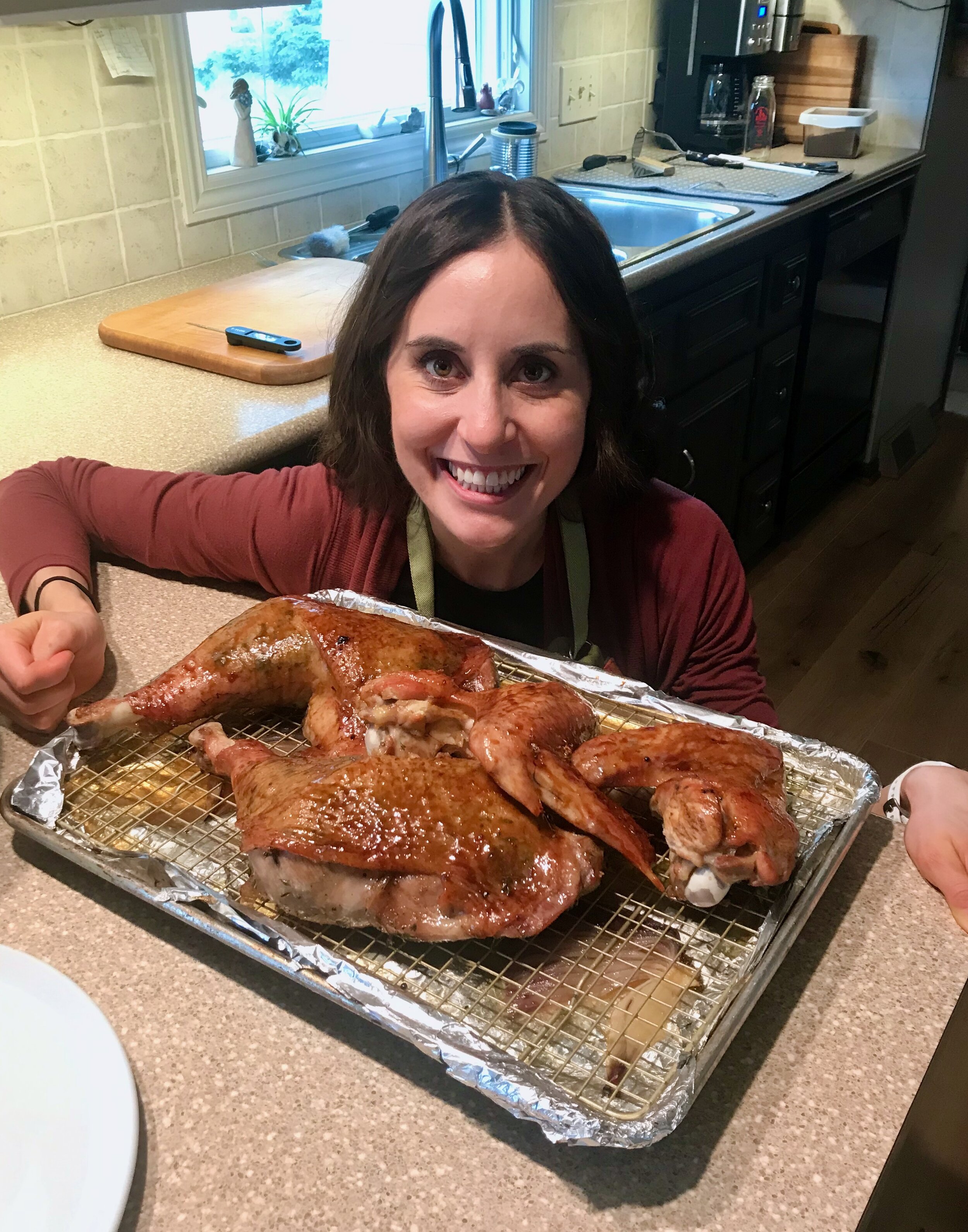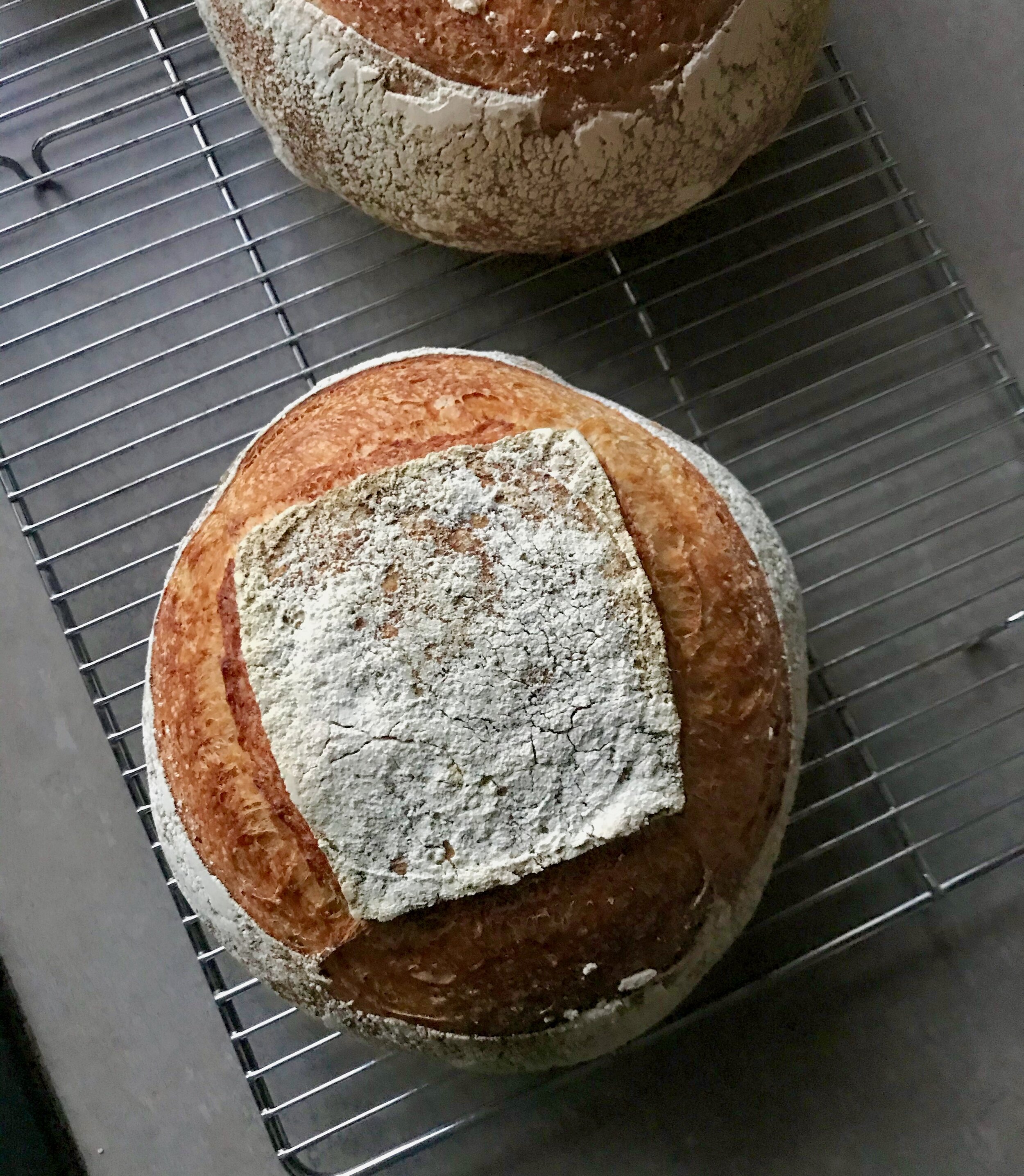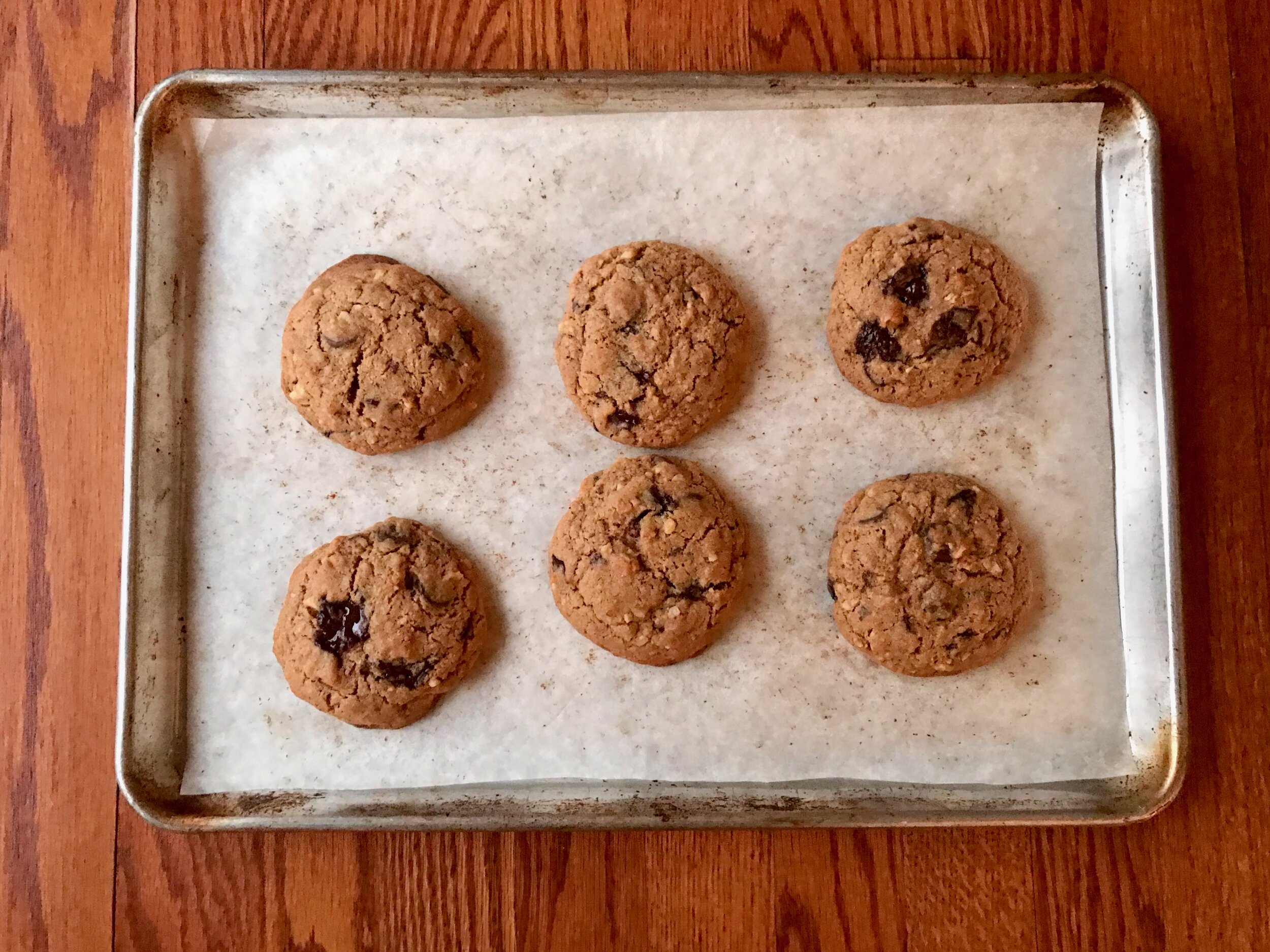Thanksgiving 2019
I love thanksgiving. It was another great one this year. There were 16 of us this year including grandpa, grandkids, an aunt and uncle, and some cousins with their kids. A good bunch! I’ve made the same turkey for the past several years. It’s from Bon Appetit and it has turned out great every year. This year I wanted a slightly bigger turkey but know that this can present a problem with roasting evenly so I decided to roast the turkey in parts instead of whole. Just a few days later, lo and behold, I was listening to Bon Appetit’s podscast where they mentioned their turkey receip this year called for the turkey to be cut into pieces before roasting. Perfect!
I listened to another podcast where Alison Roman was talking about her new cookbook and what she was going to make for thanksgiving this year and she mentioned her turkey was dry-brined in a mixture of herbs and brown sugar, and then stuffed with lemons and red onion. I thought this flavor combo sounded great so I decided to combine the two recipes.
I cut the turkey into parts (2 leg/thigh combinations, 2 wings, and one double breast) and then dry brined it (it was a 21.4 pounder this year so I increased the total amount of dry brine accordingly) in Alison’s mixture of sugar, salt and thyme but added in a good amount of lemon zest. I let that sit for 2 days on baking sheets in the fridge, uncovered. I then baked it on Thanksgiving morning following the Bon Appetit method, on a wire rack at 425 degrees initially, and then decreasing to 300 degrees until done. I put a few cut up red onions and two full heads of garlic under the wire racks as well. I glazed with the Bon Appetit glazed as well, but substituted lemon for orange. It ended up baking at 450 degrees (I decided to up the temp just a bit since my bird was so big) for 25-30 minutes, and then another 60-65 minutes at 300 degrees. I had to pull the legs a few minutes before the breast was done.
The final result? It was great! Both the white and dark meat were cooked perfectly, no dry over-cooked breast meat here. I let the turkey sit for about an hour before carving. While it was resting I made Alison Roman’s turkey gravy which turned out beautifully smooth and glossy. It was rich and buttery and so delicious. Overall the combination of recipes and a fresh local turkey came together for another win.
Had one fail this year, thankfully it wasn’t the turkey. And thankfully I had the time to fix it! In addition to the turkey, every year I also enjoy making dinner rolls. This year I was planning on making two different recipes; a simple sourdough white roll, and a slightly sweetened molasses and oat sourdough bun which was dairy free for some family members with food intolerances. Since the molasses buns were a new recipe I tested them twice, TWICE in the week before Thanksgiving and was feeling good about them.
I started these rolls again the Tuesday night before Thanksgiving. The first rise went fine, but after shaping them on Wednesday I left them in the fridge overnight for the second rise. In the morning they didn’t look like they had done a lot, they were still pretty flat, but I had to get them in the oven so in they went after warming on the counter for an hour or two. In the oven they did not rise at all. Not one millimeter. They came out as flat little pancakes of dense dough. I have no idea what went wrong. I know the started was active because I used the exact same starter for the other batch of sourdough rolls and those rose just fine.
I was stumped but didn’t have time to dwell on it. I thankfully knew I had time to whip together something else and get it baked before everyone showed up at 12:30. I found a good basic soft and buttery dinner roll on a dependable blog. I’ve made very similar recipes in the past and knew it would probably be fine. It was. This recipe was simple and rose easily and baked up like a dream. They were not dairy free but they were delicious so that’s what we went with! Phew, saved the rolls!
——————————————————————————————
Spiced and Glazed Roast Turkey
From Bon Appetit
Ingredients
Turkey
1 12–14-lb. turkey, cut into pieces
2 Tbsp. whole black peppercorns
2 Tbsp. whole pink or black peppercorns
½ cup Diamond Crystal or ¼ cup plus 1½ tsp. Morton kosher salt
2 Tbsp. garlic powder
2 Tbsp. onion powder
1 Tbsp. light brown sugar
1 Tbsp. smoked paprika
Glaze and Assembly
Small handful of hardy herbs (such as sage, rosemary, bay leaves, and/or thyme)
4 garlic cloves, crushed
2 2x1" strips orange zest
⅓ cup low-sodium soy sauce
⅓ cup (packed) light brown sugar
⅓ cup sherry vinegar or red wine vinegar
6 Tbsp. neutral oil (such as vegetable, peanut, or canola)
Brining the Turkey: Place turkey pieces, skin side up, on a wire rack set inside a rimmed baking sheet. Sprinkle salt mixture liberally all over turkey, patting to adhere. You may not need all of it, but it’s good to have extra since some will end up on the baking sheet. Chill bird, uncovered, at least 24 hours and up to 2 days.
Glaze and Assembly: Remove turkey from wire rack and rinse baking sheet and rack if needed (turkey will most likely release some liquid). Line baking sheet with 3 layers of foil to make cleanup easy and set rack back inside. Arrange turkey pieces on rack, skin side up, and let sit at room temperature 2–3 hours to help decrease the cooking time.
Meanwhile, cook herbs, garlic, orange zest, soy sauce, brown sugar, and vinegar in a small saucepan over medium heat, stirring occasionally, until sugar is dissolved and glaze thickens slightly (it should just barely coat a spoon), 10–12 minutes. Remove glaze from heat.
Place a rack in middle of oven; preheat to 425°. Rub turkey with oil and pour 1 cup water into baking sheet. Roast turkey, rotating baking sheet halfway through, until skin is mostly golden brown, 20–25 minutes. Reduce oven temperature to 300° and continue to roast turkey, brushing with glaze every 20 minutes and adding more water by ½-cupfuls as needed to maintain some liquid in baking sheet, until an instant-read thermometer inserted into the thickest part of breast registers 150°, and 170° when inserted into the thickest part of the thighs, 50–70 minutes longer (total cooking time will be 1–1½ hours). [Mine ended up going an additional 60-64 minutes] Skin should be deep golden brown and shiny. Transfer turkey to a cutting board; tent loosely with foil. Let rest 30–60 minutes before carving.
——————————————————————————————
Dry-Brined Turkey with Sheet-Pan Gravy
From Alison Roman
Ingredients
Turkey:
1 bunch fresh thyme
⅓ cup kosher salt
⅓ cup light brown sugar
2 tablespoons coarsely ground black pepper
1 12- to 14-pound turkey
4 to 5 medium red onions, quartered
3 lemons, halved crosswise
2 heads garlic, halved crosswise
⅓ cup olive oil
6 tablespoons unsalted butter
Gravy:
3 cups Chicken or Turkey Stock, plus more as needed
6 tablespoons unsalted butter
½ cup all-purpose flour
2 tablespoons low-sodium soy sauce, plus more to taste
2 tablespoons apple cider vinegar or white wine vinegar, plus more to taste
Kosher salt and freshly ground black pepper
Turkey: Strip the leaves from 4 sprigs of thyme, and coarsely chop the leaves. Place in a medium bowl along with salt, brown sugar and pepper; mix to blend well.
Place the turkey on a rimmed baking sheet lined with a wire rack. (If you do not own a wire rack, just place the turkey directly on the baking sheet.) Make sure the giblets (the bagged heart, kidneys and liver, and the neck) are removed from the cavity. Using paper towels, pat the turkey dry on all sides. Sprinkle with the salt mixture, making sure to distribute the seasoning evenly to all the bits and parts. Refrigerate turkey, uncovered, for 8 to 24 hours — the longer, the better.
Heat oven to 325 degrees. Remove turkey from the fridge, and transfer it to another clean rimmed baking sheet (discard any liquid that has accumulated on the first baking sheet). Stuff turkey with remaining bunch of thyme, a few of the quartered onions and half of the lemons and garlic. Scatter remaining onion quarters, lemons and garlic around the turkey. Combine olive oil and 6 tablespoons butter in a small pot over medium heat until butter is melted. Pour half of the mixture over the turkey and onions. Toss the onions lightly to evenly coat; season everything with salt and pepper.
Roast, rotating the baking sheet every hour or so, until the turkey has reached 160 degrees when a thermometer is inserted in the deepest part of the thigh, 2½ to 3 hours. The turkey will be cooked through and tender, and the skin will be brown, but you can and should get it browner.
Increase temperature to 425 degrees. Pour remaining butter mixture over the turkey (warm it slightly if solidified) and continue to cook until the internal temperature reaches 165 degrees and the skin is very deeply browned all over, 20 to 25 minutes. It's OK if the internal temperature is just shy of 165 degrees, it will come to temperature as it rests. (If you find the skin is browning too quickly, especially on the top at the breast, place a sheet of foil over the breast.)
Remove turkey from the oven and let rest on the baking sheet for 30 minutes (and upward of 45 minutes). Tip the turkey, cavity-side down, making sure the aromatics stay inside the cavity and letting any juices run out onto the rimmed baking sheet. Transfer the roasted onions, lemons and garlic to another dish and set aside. Transfer the turkey to a cutting board and let it continue to rest while you make the gravy.
Gravy: Pour about 1 cup stock onto the baking sheet. Using a spatula, scrape up the bits from the turkey drippings, just as if you’re deglazing a skillet after searing a piece of meat. Carefully pour the contents of the baking sheet into a large measuring cup or other spouted vessel. Add remaining stock until you have 4 cups liquid; you may need more or less stock depending on how juicy the bird was.
Melt 6 tablespoons butter in a medium pot over medium heat. Add flour and cook, whisking constantly, until flour is sizzling furiously and well-toasted, about the color of a graham cracker, 4 to 6 minutes. (The mixture will be thick at first but will thin as the flour cooks.) Slowly whisk in fortified stock mixture, about ½ cup at a time, letting it bubble, thicken and incorporate completely between additions until all of it has been added.
Add soy sauce and vinegar, and season with salt and pepper. Continue simmering until gravy is at your desired viscosity and the flavors have all melded together, 5 to 8 minutes. Add more soy sauce if you think it needs more depth of flavor, vinegar if you want more acidity, and salt and pepper for seasoning. Remove from heat and set aside until ready to serve.
———————————————————————————————————————————————————————————————
Soft and Buttery Dinner Rolls
From Sally’s Baking Addiction
Ingredients
1 cup (240ml) milk, around room temperature
2 and 1/4 teaspoons instant yeast
2 Tablespoons granulated sugar, divided
1 large egg
1/4 cup (60g) unsalted butter, softened to room temperature and cut into 4 pieces
1 teaspoon salt
3 cups (375g) all-purpose flour or bread flour
Optional topping: 2 Tablespoons melted unsalted butter mixed with 1 Tablespoon honey
Add flour, salt, sugar and yeast to the bowl of your stand mixer fitted with a dough hook. Whisk to combine. In a separate bowl whisk together the milk and egg - add to the flour mixture. Beat on low speed for 30-60 seconds, scraping down the sides of the bowl with a rubber spatula as needed until all of the flour is moistened. Then increase to medium speed and knead until the the dough is well developed and comes together to form a soft dough. It will be sticky. Add flour as needed to make it manageable but don’t add too much so it becomes too dry.
Lightly grease a large bowl with oil or nonstick spray. Place the dough in the bowl, turning it to coat all sides in the oil. Cover the bowl with plastic wrap, or a clean kitchen towel. Allow the dough to rise in a relatively warm environment for 1-2 hours or until double in size.
Grease a 9×13 inch baking pan or two 9-inch square or round baking pans. Set aside.
When the dough is ready, turn it out onto a lightly floured surface. Divide the dough into 14-16 equal pieces. Shape each piece into a smooth ball. Arrange in prepared baking pan. (For a 9x13 inch pan, 15 rolls is nice to arrange in 3 rows of 5 rolls each).
Cover shaped rolls with plastic wrap, or a clean kitchen towel. Allow to rise until puffy, about 1 hour. Near the end of the rising time, preheat oven to 350°F. Bake for 20-25 minutes or until golden brown on top, rotating the pan halfway through. If you notice the tops browning too quickly, loosely tent the pan with aluminum foil. Remove from the oven, brush with optional honey butter topping, and allow rolls to cool for a few minutes before serving.




































